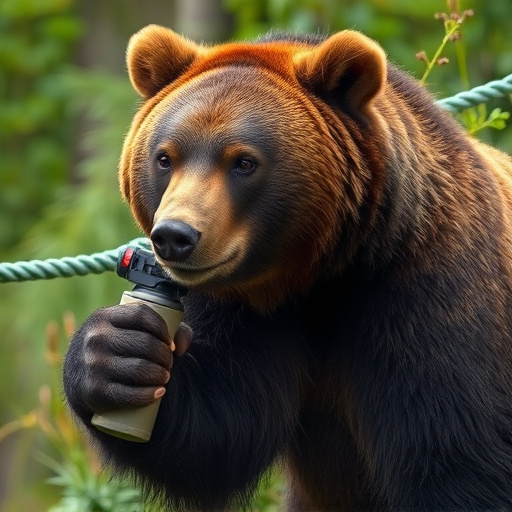For safe outdoor adventures in bear country, understanding TSA restrictions on bear pepper spray is vital. While small containers are generally allowed in carry-on luggage, there are strict size and quantity limits. Choosing the right spray involves considering capsaicin concentration, protection range, weight, and TSA guidelines for travel. Proper handling, storage, and practice sessions ensure effectiveness and responsible use against aggressive bears as a last resort. Adhering to these restrictions and practices is crucial for safety during wildlife encounters.
In regions where wildlife encounters are common, bearing protection has become essential. One effective tool gaining popularity is bear pepper spray, designed to deter aggressive bears during close interactions. This article explores the significance of bear pepper spray as a safety measure, delving into its understanding, TSA regulations on carry-on items, and crucial factors in choosing the right product for diverse needs. Additionally, it provides safe handling practices to ensure effectiveness and prevent accidents.
- Understanding Bear Spray: An Effective Safety Measure
- TSA Regulations on Pepper Spray: What You Need to Know
- Choosing the Right Bear Spray for Your Needs
- Safe Handling and Usage Practices
Understanding Bear Spray: An Effective Safety Measure
Bear pepper spray is an effective safety measure designed to deter aggressive bears during unexpected encounters in their natural habitats. It works by causing temporary blindness, coughing, and congestion in the bear, providing a crucial moment for escape or reassessment of the situation. This non-lethal option is especially valuable when hiking, camping, or exploring regions known for bear populations.
Understanding the TSA restrictions on bear pepper spray is essential for those planning outdoor adventures. The Transportation Security Administration (TSA) allows passengers to carry bear pepper spray in their checked baggage but has specific guidelines regarding size and packaging. Knowing these regulations ensures that individuals can safely transport the spray while adhering to travel security measures, thereby enhancing their overall safety during wildlife encounters.
TSA Regulations on Pepper Spray: What You Need to Know
When packing for a trip, especially one involving outdoor activities or adventures in bear country, it’s crucial to be aware of the Transport Security Administration (TSA) regulations regarding bear pepper spray. The TSA has specific rules and restrictions on items like bear pepper spray to ensure passenger safety during air travel. These regulations are in place to prevent any potential hazards or misuse of such items onboard aircraft.
Bear pepper spray, also known as bear repellent, is a popular choice for individuals seeking protection against aggressive bears while hiking or camping. However, due to its potent nature and the possibility of accidental discharge, the TSA has strict guidelines on its transport. Passengers are typically allowed to carry small containers of bear pepper spray (usually in liquid or aerosol form) in their carry-on luggage, but there are size and quantity limitations. It’s essential to check the TSA website for up-to-date information on permitted sizes and to ensure your spray meets their criteria before packing.
Choosing the Right Bear Spray for Your Needs
Choosing the right bear spray is crucial based on your specific needs and environment. Key factors include concentration of capsaicin (the active ingredient), range and duration of protection, weight and size for ease of carrying, and any TSA restrictions if you plan to travel with it. Bear pepper sprays come in various strengths, typically ranging from 1.5% to 3% capsaicin. A higher concentration offers more power but may be too intense for some users; a lower one is gentler on the skin but might not stop an attack as effectively.
Consider where you’ll be using it—backcountry hiking, camping, or urban areas with potential bear sightings. Some bear sprays are designed for close-range defense, while others offer a wider range, allowing for more distance between you and the bear. Additionally, check if your chosen spray complies with TSA regulations if you intend to carry it on flights. This ensures smooth travel and easy access in case of an encounter during your journey.
Safe Handling and Usage Practices
When handling bear pepper spray, safety is paramount. Always store it in a cool, dry place away from direct sunlight and out of reach of children or pets. Ensure the container is not damaged before use; any cracks or leaks could compromise its effectiveness. Familiarize yourself with the spray’s functionality; practice aiming and activating it in a controlled environment to understand its range and duration.
Usage should adhere to both product instructions and TSA restrictions for carry-on luggage. Only use bear pepper spray as a last resort when confronted by an aggressive bear. Aim for the bear’s face, eyes, and nose to maximize impact while minimizing blowback onto yourself. After deployment, move away from the area quickly and calmly, seeking shelter or assistance if needed. Remember, proper handling and responsible usage are key to ensuring its effectiveness in potential wildlife encounters.
When it comes to wildlife encounters, especially with bears, having the right bear pepper spray can be a game-changer. Understanding the effectiveness of bear spray, familiarizing yourself with TSA regulations on pepper spray, and choosing the suitable product for your needs are essential steps towards ensuring safety in bear country. Always follow safe handling practices to maximize its potency. Remember, knowledge and preparation can make all the difference when navigating through potential bear encounters, so be sure to stay informed about local guidelines and restrictions, including TSA restrictions on bear pepper spray.
